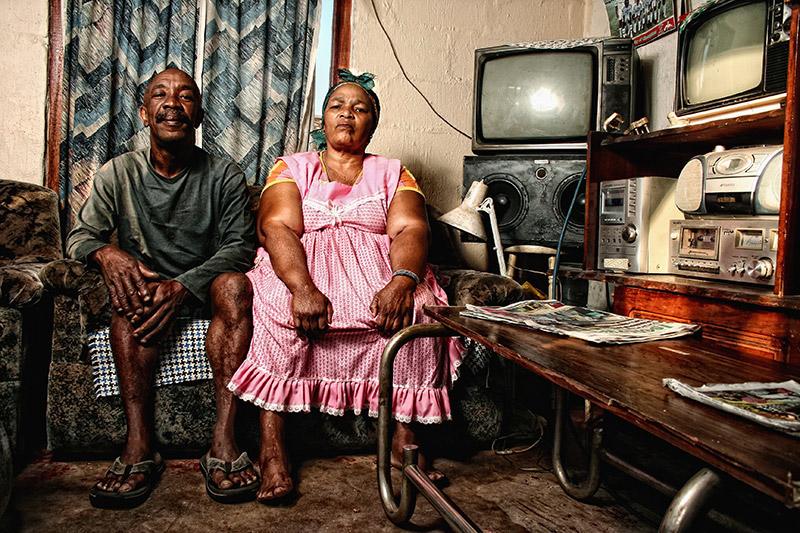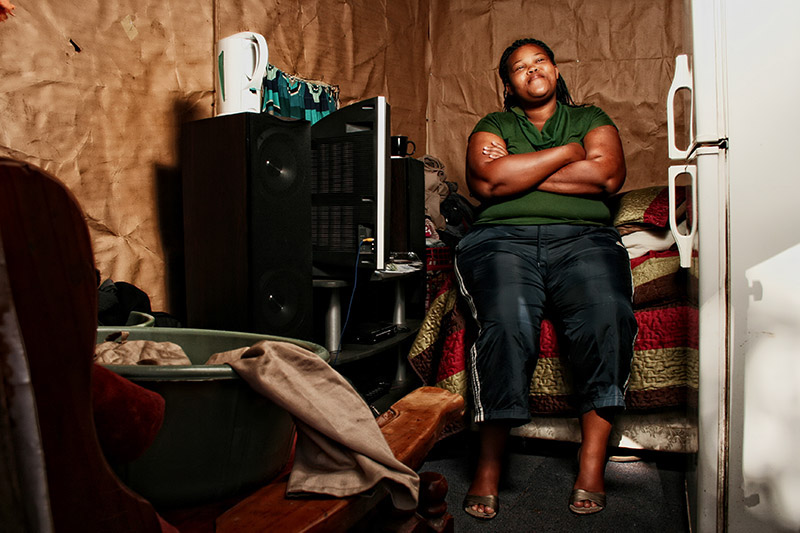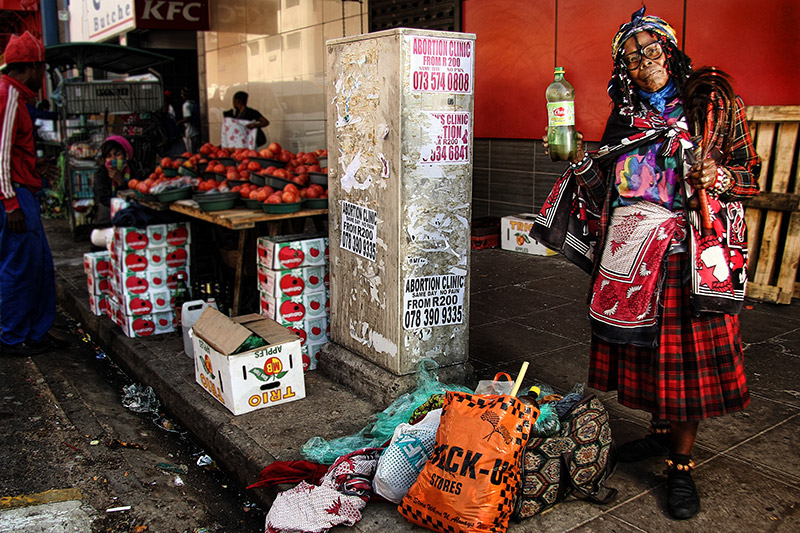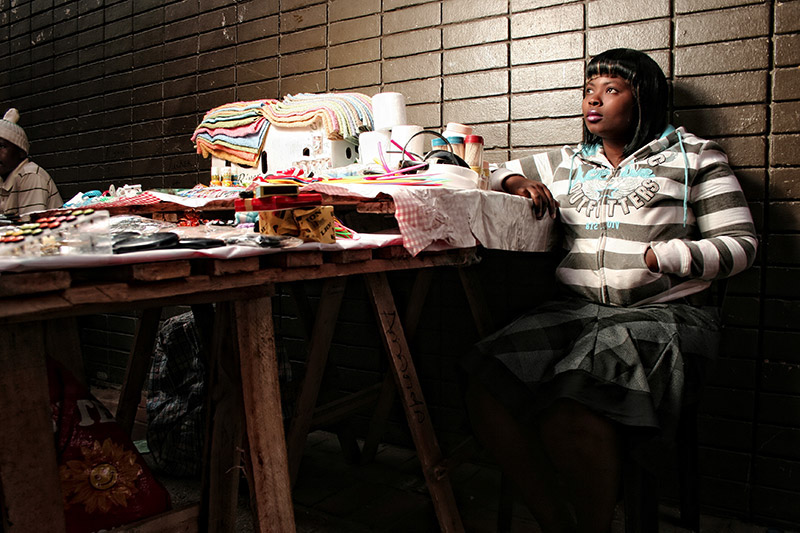All city’s have many sounds and many differentkinds of people. This project was about photographically documenting thedifferent traditions and cultures that reside on the streets of Durban. We areall connected by the street. The moving of light through pathways is like themovement of our eyes that follow down alleyways’ as we drive through the city.We see the street people, we think we know where they come from but we truthfullydon’t. This project is about showcasing these people living their lives.
This project is my photographic documentation of Durban and its surrounding townships. The following captions are snippets from a book that I am currently trying to get published on this work and my adventures on the streets and townships of Durban.

This first image is a dedication to Archie Mathews. This man was someone who I met on the streets of Durban ( Sydney Road) and who then took me into the homes of his family and friends in the townships surrounding Durban. Archie Mathews stayed as my guide for a couple of months.
"As I walked across the road andcame near the woman a man by the name of Archie spoke up.”Hey boy, what do youwant?”I turned and looked at the man.”Yebo Sawabona." was my response, I thenexplained that I was doing a project on South African culture and his eyesopened up, “Mama get your shop ready the boy wants to take photos.”The lady’sshop was a few round silver pots boiling pieces of pig for her customers."


"Seeing how these people live isan eye opener. The way people live that differs from the way I live.Differences such as IJUBA a traditional Zulu beer that can be sold for R5 inmilk like cartons, or is home brewed. Living off candle light, such a thing weonly experience when going camping but people here use it as a source of lightevery day in their tin houses. Sometimes their clothes are so close thatcatching on fire is an 80% chance of happening each and every day but there isno alternative. That’s all the space that there is.
Newspapers and magazine clippingsall over the walls of a tin house is also common practice for these individuals.Anything to brighten the mood from the dull tin colour that forms the walls oftheir homes."





"The promise of an African slaughter has become a rumour to my ears yet Archie insists that this time I will be able to get my chance to document it. It’s a strange concept, wanting to document a slaughter but there is a magical aspect to it I believe. To be able to earn the trust of a community so much that they allow you to come into their home and document their traditions that is magical to me. As I have been taken out of my comfort zone in order to pursue this book, so have the people been, allowing me into their homes, giving a complete stranger glimpses into the most intimate moments of their lives can be no easy feat."

"12 o’clock came and went and there was still no signof any cow. 2 o’clock in the afternoon came and passed. Starving at this pointrealizing that I had not eaten at all that day, 4pm comes and we head back downto the house where the slaughter would take place. Archie tries to find outwhat is the delay and no one knows why there is a delay and everyone is waitingin anticipation. Family friends have arrived and are sitting down sharingstories over a bottle of beer or two.
Finally the cow arrives at 5pm. A white truck parksoutside the yard, the cow backing towards the front of the truck moving awayfrom the people that are now surrounding the truck and hitting the bars withsticks egging the cow on. A hoof slams the floor of the truck and you can feelthe fear in the cows body language. Ropes are being brought to the older men ofthe group and the people climb on the truck and lasso the cow with ropesholding it in place so that it does not try get away. The doors of the truckare then opened and the cow is directed towards a aged tree in the garden.Stomping and mooing causing waves of dust to fly into the air as the cow is nowbeing pulled head first into the tree and tied down so that the ceremony canbegin."
Finally the cow arrives at 5pm. A white truck parksoutside the yard, the cow backing towards the front of the truck moving awayfrom the people that are now surrounding the truck and hitting the bars withsticks egging the cow on. A hoof slams the floor of the truck and you can feelthe fear in the cows body language. Ropes are being brought to the older men ofthe group and the people climb on the truck and lasso the cow with ropesholding it in place so that it does not try get away. The doors of the truckare then opened and the cow is directed towards a aged tree in the garden.Stomping and mooing causing waves of dust to fly into the air as the cow is nowbeing pulled head first into the tree and tied down so that the ceremony canbegin."

"The next time I look at the time its 8pm stillstanding in the township, my umbrella and shoes covered in the animals blood,the cow is almost gone a few more hacks with the rusty axe and buckets filledwith blood the meat will be separated from the tablecloth skin and kept in acement room for the evening. The last bit of blood is being soaked up, feelingextremely tired now I pack up my equipment into the bag. I sit down next toArchie and see people cooking pieces of meat on a warm fire that had been cutoff the animal, bags of salt lying open for the meat to be dipped into beforeeaten."
"Time to leave and it’s hard to drag Archie away fromhis friends. The now drunk and high Archie Mathews is swinging his arms intothe air telling a story to the people that surround him and he then saysfarewell, before we leave we walk into the house to say our goodbyes.
Blood stains the floors , walking through the doorover splatters of blood and into the next room, not sure what is actually goingon Archie turns around and says, “It is not satanic its tradition.” Anotherstep into the living room and there is blood trailing from the outside door andinto the kitchen, living room and then main room of the house. We sit downwaiting for the other people to give their respects and then Archie tells me togo inside and say goodbye.
I walk into the room, the widowed wife is lying on thebed not able to move only able to see who it is, I try say goodbye and thanksfor allowing me to document their traditional slaughter. In the corner of my eye there isthe cows chopped head on the floor of the room, blood oozing outwards trying toescape. Hanging from the ceiling tied by rope is the cow’s ribs and tail, flieslanding and taking off from the carcass taking a bite to eat with each swoop. Iturn around wishing that I could take a photo of this, however I was notallowed to take any images of the widow. I try my luck and ask thegranddaughter but there was no way I would get permission to document this. Isay my goodbyes and leave the property, with the walk back up the hill to mycar I ask why the cows head and sides were in the room, Archie cannot tell menor could Mr. D, all they could tell me was that it was tradition and how ithas always been done."




"I found myself walking intoan alleyway just off Monty Naicker Street. This alleyway was a vibrant communitywith people and their set up shops made from cardboard and wooden tables. The kaleidoscopeof colours stemmed from what people were wearing and the amount of vegetablesand fruit that was being sold made for interesting photographs."











"I find a young boy pulling at myjersey asking me to follow him. There is always that fear of where he is leadingme but there is also an excitement. Usually when people ask you to follow themit turns out to be something fascinating. I follow the boy and his bicyclearound the buildings till he leads me to a group of men smoking a joint.
The men see me and my camera. Theystart talking to themselves in the rugged torn clothes and then a man says”What are you doing here? Is this for the newspaper?” I explain that I amputting a book together and that I am a student here to document the hiddenside of Durban. The man turns around and asks his friends to move aside. Behindthem is a glass fish tank.
The men see me and my camera. Theystart talking to themselves in the rugged torn clothes and then a man says”What are you doing here? Is this for the newspaper?” I explain that I amputting a book together and that I am a student here to document the hiddenside of Durban. The man turns around and asks his friends to move aside. Behindthem is a glass fish tank.
Inside this fish tank are whiterats with red eyes. The man kneels down on the dusty ground and picks up one ofthe rats and the rest pile in. I start snapping away taking images that wouldbest reflect this. I did not expect to find anything like this here. This isthe side of Durban that I have wanted. The side of Durban that intrigues us andbewilders us and this was definitely a bewildering sight to behold. I have seenmany things this year but this was definitely the most wholesome and fun partof Durban’s hidden culture that I had the pleasure to document. The sad truthabout going into these kinds of places is that the joyful feeling of capturing anenlightening photograph doesn’t last very long. As I turned to see what elsewas around to document from this small community I see a baby girl with tornclothes sitting on the dusty ground baking in the sun. She moves her fingersback and forth over a dirty polystyrene fast food container trying to scrapeoff left over sauce and crumbs to put it in her mouth. I turn my camera in her direction.The child’s mother had spotted me and went to pick up her daughter before Icould take a picture.
I have tried hard to capturepeople in a positive light but the truth is that every where one goes there isalways poverty. I have captured people this year that are making the best ofwhat they have been given, making something of what they were born into. Itdoesn’t mean that it is good or bad. It simply means they are surviving.
I packed up and went home afterthis image and knew this was the last for this year of the township and streetspoverty stricken culture that I would be capturing."



